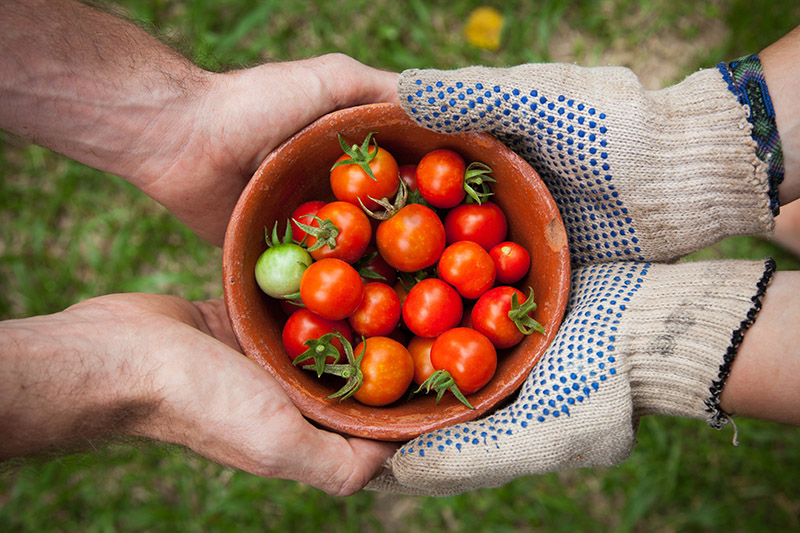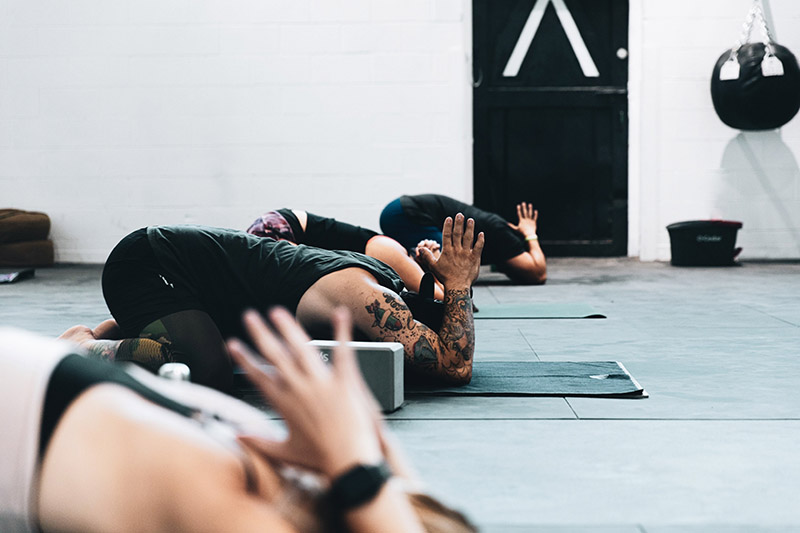You likely won’t learn about yoga philosophy in a modern-day yoga class, yet it is the backbone of the practice,
The five Yamas, the first of the eight limbs of yoga, are moral codes that allow you to cultivate more ethical behavior towards others, yourself, and the world. Therefore, there are essential teachings for every modern-day yogi who seeks to understand the origin of this profound practice.
In this article, we’re diving deep into the fifth Yama, Aparigraha. So read on to discover how this Yama can help you release physical and mental baggage, heal past hurts, and find more inner peace.
Contents
What Is The Meaning Of The Sanskrit Word Aparigraha?

According to The Yoga Sutras by Patanjali, the word Aparigraha means non-greed and non-possessiveness. Sutra 2.39 refers to this Yama, stating that “when a yogi is steadfast in non-covetousness, knowledge comes of the wherefore of his births.”
Non-covetousness means not wanting something that is not yours, which relates to the third Yama, Asteya, too. Aparigraha means not to accumulate (or desire to collect) more material things than you need.
Why is this important? Because if you want to advance spiritually, you need to move away from the material world; thus, you should be reducing, not increasing, your possessions. When you do this, yoga sutra ii suggests you will gain deeper inner wisdom and higher knowledge.
Non-attachment is a fundamental teaching in both yoga philosophy and Buddhism. Buddhist monks are well known for their lack of attachment to material things and for letting go of the self. For example, when someone becomes a monk, they are expected to renounce their possessions and swap their clothes for orange robes. They even shave their heads, releasing any attachment to their hair.
What’s more, for everyday Buddhists, the teachings tell them to give away anything they have in excess to someone in need, such as food or money. Therefore, for many of us in the western world, Aparigraha teaches us to be more like the Buddhists.
Let’s not forget that all the Yamas have direct and indirect teachings. Therefore, the fifth Yama, Aparigraha, is about freeing up your physical space and clearing your mental baggage and emotional pain from past experiences to experience greater enjoyment in life.
For reference, the other four Yamas are:
- Ahimsa (non-violence)
- Satya (truthfulness)
- Asteya (non-stealing)
- Brahmacharya (correct use of energy)
How To Practice Aparigraha In Daily Life

Practicing Aparigraha benefits all aspects of our lives. Here are some ways to practice non-accumulation in your physical and mental space.
Practice minimalism
As Aparigraha relates to non-possessiveness, one excellent way to practice this Yama is by having a clear-out in your home. In this modern world where we are bombarded by advertising and the fast fashion industry makes stylish clothes affordable, we quickly accumulate material possessions.
However, having too much stuff doesn’t just take up physical space; it can also affect our minds and energy. Often times a cluttered environment equals a cluttered mind and can cause you to lose sight of what is really important. The more things you own, the more likely you will develop an attachment to material possessions and even become reliant on them.
However, a clean, tidy, and orderly living space with minimal furniture will do more than just make your rooms spacious. When you clear out the excess in your home and break your attachment towards items by giving or throwing them away, you’ll notice your mind becomes clearer too.
This type of non-attachment helps you become more self-reliant, as you realize you can survive and even thrive without all the things you were hoarding. You can then continue to practice minimalism by buying what you need only, or in other words, the smallest possible amount. By adopting this lifestyle, you’ll enjoy greater independence and self-reliance.
Practice forgiveness and unconditional love
Aside from giving up our material possessions, practicing Aparigraha is about letting go of negative emotions and thought patterns that stop us from living freely.
As human beings, it’s only natural to experience challenging moments when others betray our trust or cause us pain. Forgiving those that hurt us is not easy. Still, when we hold onto grudges, we choose to trap ourselves in a constant state of negativity.
Moreover, sometimes it is ourselves that we cannot forgive. For example, perhaps you made a silly mistake that cost you your job, relationship, or something else important. When this happens, it’s OK to acknowledge what you did was wrong, but it is not intelligent to keep beating yourself up about it. The only way you will be able to move on and continue living life is to practice forgiveness and unconditional love towards yourself.
Non-forgiveness can keep you stuck in a vicious cycle. Still, when you choose to forgive your or others mistakes, you will release energetic baggage that has been holding you back. So practice Aparigraha by not allowing hurtful words or actions to hold space in your mind.
Be generous

You can also practice Aparigraha by following the Buddhist teachings around non-greed and non-attachment, giving things away without expecting to receive anything in return.
If you have an excess amount of money, donating some to a worthy cause is a great act of unselfishness. However, generosity can be practiced in many ways, not involving money. For example, you can volunteer at a charity, bake cookies for your neighbors, or offer to babysit to give a friend or family member a night off.
However, one of the best acts of generosity is to share your knowledge or connections with others. Unfortunately, many people refrain from doing this as they think they will lose something as the other person gains something. This comes from a scarcity mindset, which you can overcome through self-study and personal development.
When you can share freely with others, you’ll start to live with a mindset of abundance and positivity, which will increase your life force and the feeling of sheer joy.
Eat mindfully
One of the most common ways we can be greedy is when it comes to food. Yes, food is delicious, but eating more than we need harms our bodies more than does it good. If you struggle with binge eating or overeating, you most likely see food as an emotional fix or a distraction.
When we eat a piece of chocolate cake, we initially feel good. However, if you go back for a second slice, then a third slice, and so on, the experience changes. Once we get greedy, the food no longer feels satisfying. After a while, we may feel sick physically and towards ourselves due to our behavior.
So to practice non-greed, imagine food as purely fuel to keep your body going, removing all emotion around it. Then eat slowly, chewing each mouthful multiple times. Finally, practice the Ikigai 80% rule by eating until you are only 80% full.
How To Practice Aparigraha Towards Yourself

The above ways of practicing Aparigraha will positively impact your life and wellbeing. Still, there are also some ways you can directly practice this Yama towards yourself.
Stop clinging to memories
We can sometimes hold onto emotions by clinging to memories we wish didn’t end. For example, we may attach to how we felt during the honeymoon phase of a new relationship. This memory might make us desire our relationship to be as good as then. However, clinging onto memories in such a way is going against Aparigraha.
Aparigraha teaches us that change is inevitable and that emotions, thoughts, and situations are fleeting. If someone who used to love you no longer does, clinging to them is like holding onto a material object that we once adored but is now rotting or rusting.
Unhealthy attachment to the past prevents new (and often better) opportunities from arising. So practicing the Aparigraha Yama and non-attachment is about allowing things to unfold naturally and flow smoothly in one’s life.
Make time for self-care
The need to cling and hold onto things usually comes down to insecurity. Looking to others for support is not bad, but when we feel so insecure that we have to rely on others, we lose our independence.
Taking time for and nurturing ourselves is one of the best ways to build our self-image, confidence, and independence. The more time we dedicate to our well-being, the more we develop self-reliance and confidence.
Some self-care practices that can help you improve your self-worth and relieve anxiety are:
- yoga
- meditation
- spending time in nature
- going for walks
- treating yourself to a massage or facial
Moreover, making time to do something you genuinely enjoy is the best gift you can give yourself. So whether you love to dance, paint, write, or knit, schedule regular time to practice and improve your favorite hobby, either on your own or in a group class.
How To Practice Aparigraha In Asana Practice

Like all the Yamas and Niyamas, practicing Aparigraha on the mat is just as essential as introducing it into everyday life. Here’s how this teaching relates to yoga practice.
Keep your yoga space clear and tidy
One of the most obvious ways to practice non-accumulation on the yoga mat is to ensure the space around you is clutter-free. Now, if you’re practicing yoga at home, you may not have the luxury of having your own yoga room. However, you can still practice Aparigraha by clearing up anything on the floor near your mat, such as kids’ toys.
Let go of expectations
Attachment and possessiveness come down to the need to feel in control. We can experience this in our yoga practice when we set unrealistic expectations to master asanas that our bodies are not yet ready for. For example, if you set a goal to learn handstand in one week, there’s a good chance you will be disappointed.
Therefore, one way to practice Aparigraha on the mat is to let go of expectations around the outcome of your session. By practicing non attachment, you release the need to feel in control and the possessiveness that comes with that. So for your next yoga class, set the intention to simply go with the flow and see how much more freeing and enjoyable your practice feels.
Breathe deeply

As we mentioned earlier, insecurity and anxiety are common root causes of attachment and possessiveness.
Your breath is the best tool for dealing with these feelings, and your yoga practice is the best time and place for making use of it. Your breath connects you to the present moment, getting you out of your head and into your body.
When you’re focusing on your breathing, your mind cannot be swayed by thoughts of the past or future; it stays locked in the here and now where you can think clearly and let things be. So while on your yoga mat, practice breathing deeply with each asana.
If doing sun salutations, link one posture to one slow and full inhale or exhale. Then when you’re holding asanas, take five deep and conscious breaths staying focused on the sensations in your body. Its also worth adding pranayama breathing techniques to your practice, particularly Nadi Shodana (alternative nostril breathing), which is calming and soothing.
Remember that deep breathing is something you can practice multiple times throughout the day, too, not just on your mat. Whenever you notice anxiety creeping in, close your eyes and breathe in for a count of four and out for a count of four for at least one minute.
Switch it up
In yoga, as in life, we can become set in our ways when we get too attached to something. On the mat, this can manifest as always practicing the same asanas or sequence. For example, if you love Ashtanga yoga, you may only want to practice this style and feel fearful about trying a new one.
Fear of change is a familiar feeling that comes with an unhealthy attachment, so to prevent it, you should try to switch up your yoga routine. You can do this by trying a different style, teacher, or studio or learning more challenging asanas.
If you worry about hurting yourself when trying challenging asanas, attend an intermediate yoga class or workshop. Here you can explore more advanced postures in a safe and supportive environment.
However, keep in mind when learning new postures to be patient and allow the process to go at its own pace. If you cannot do a headstand the first, second, or tenth time you try, don’t worry. Don’t force the asanas or get too attached to the results, as that defeats the purpose!
Lastly, even small changes can make a difference. So if you usually practice first thing in the morning, you can switch it up by practicing at a different time. Change is always good, as our resistance to change is what increases attachment and possessiveness and thus, prevents us from living freely.
Final Thoughts

Practicing Aparigraha helps us experience more peace, clarity, and self-reliance in daily life and on the mat. The Yama of non attachment, along with the other four Yamas, are the foundation of the eight limbs of yoga. By inviting these ethical teaching into our lives, we’ll find a deeper experience of yoga and more connection with ourselves and the divine, the greatest reward we could receive.


